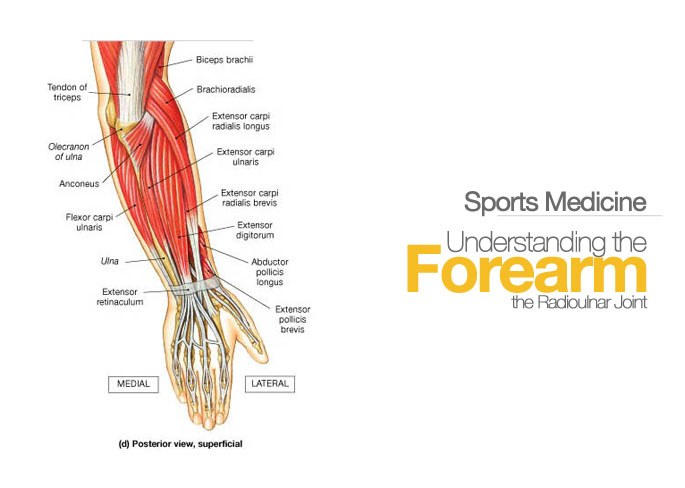
Sports Medicine
Understanding the Forearm
The forearm can can sometimes be ignored when it comes to sports medicine. Maybe because it is not as commonly injured as other joints like the shoulder or knee. However, it is important to know its anatomy and functionality in order to understand the power it has to support your upper body.
The radioulnar joint is a combination of three joints located at the the wrist, elbow and in between the ulna radius bone. These joints are not very stable and the surroundings ligaments provide the needed support. The interosseous membrane, which is located between the shafts of the radious and ulna along their entire length, make up the middle joint. This membrane helps to prevent the ulna and radius from sliding past each other. Because the muscles are also attached to the interosseous membrane, it acts to transfer stress from the radius and ulna.
The movements of the radioulnar joint consist of pronation and supination. At the elbow the radius rotates around the annular ligament and does not change online slots positions relative to the ulna. At the wrists, when the forearm is in pronation, the radius crosses over the ulna so that it is then on the inner side of the ulna. When the forearm is in supination the radius is on the lateral side of the ulna.
The muscles of the radioulnar joint act as stabilizers and produce either pronation or supination. This includes the biceps, supinator, pronator teres and pronator quadratus. The pronator quadratus and the supinator are situated so that they pull from the ulna on the radius to produce pronation and supination respectively. The pronator teres has a stabilizing component but also pulls across the elbow and is thus involved in elbow flexion when the resistance is great. It also counteracts the pull of the biceps for supination when performing elbow flexion.
The attachement of the biceps on the medial side of the radius allows the biceps to produce supination when the forearm is in pronation. When the forearm is pronated the tendon of the biceps is wrapped around the radius. This positioning causes the biceps to be weak in elbow flexion. This is why a pull-up is easier to perform when the forearm is supinated.
A similar situation occurs with the brachioradialis. Its attachments on the inner side of the humerus and outer side of the radius make it a pronator to the neutral position. When the forearm is pronated, the biceps and the brachioradialis work together in supination. The brachialis plays no role in radioulnar movements because it is attached to the ulna. This particular arrangement of the elbow flexors must be taken into account when analyzing elbow flexion exercises.
Orthopedic Corner | Leon Mead MD Orthopedic Doctor | 730 Goodlette Road North, Suite 201 Naples Florida 34102 | Phone: (239) 262-1119

